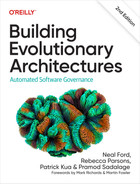Foreword to the Second Edition
A metaphor attempts to describe similarities between two unrelated things in order to clarify their essential elements. A good example of this is with software architecture. We commonly attempt to describe software architecture by comparing it to the structure of a building. The things that make up the structure of a building—its outer walls, inner walls, roof, room size, number of floors, even the location of the building—all relate to structural elements of software architecture—databases, services, communication protocols, interfaces, deployment location (cloud, on-premises), and so on. The old view is that in both cases these are things that, once in place, are very hard to change later. And that’s exactly where the building metaphor breaks down.
Today, the building metaphor for software architecture is no longer a valid one. While it’s still useful to explain what software architecture is to a nontechnical person in terms of comparing the structure of a system, software architecture must be malleable enough to change quickly, which is very different from a physical building. Why must software architecture be so malleable? Because businesses are in a constant state of rapid change, undergoing mergers, acquisitions, new business lines, cost-cutting measures, organizational structures, and so on. However, so is technology, with new frameworks, technical environments, platforms, and products. To properly align with the business and technology environment, software architecture must change as well, and at the same rapid pace. A good example is a major acquisition by a large company. Aside from the myriad business concerns and changes, the software architectures supporting the major business applications must be able to scale to meet the additional customer base and must be both adaptable and extensible to accommodate new business functionality and practices.
Many companies already know this but struggle with one thing: how do you make software architecture malleable enough to withstand a fast rate of business and technology change? The answers are found in this book you are about to read. This second edition builds on the concepts of guided and incremental change introduced in the first edition to provide you with the latest techniques, knowledge, and tips on fitness functions, automated architectural governance, and evolutionary data to make sure your software architectures are agile enough to keep up with the constant change we are all experiencing today.
